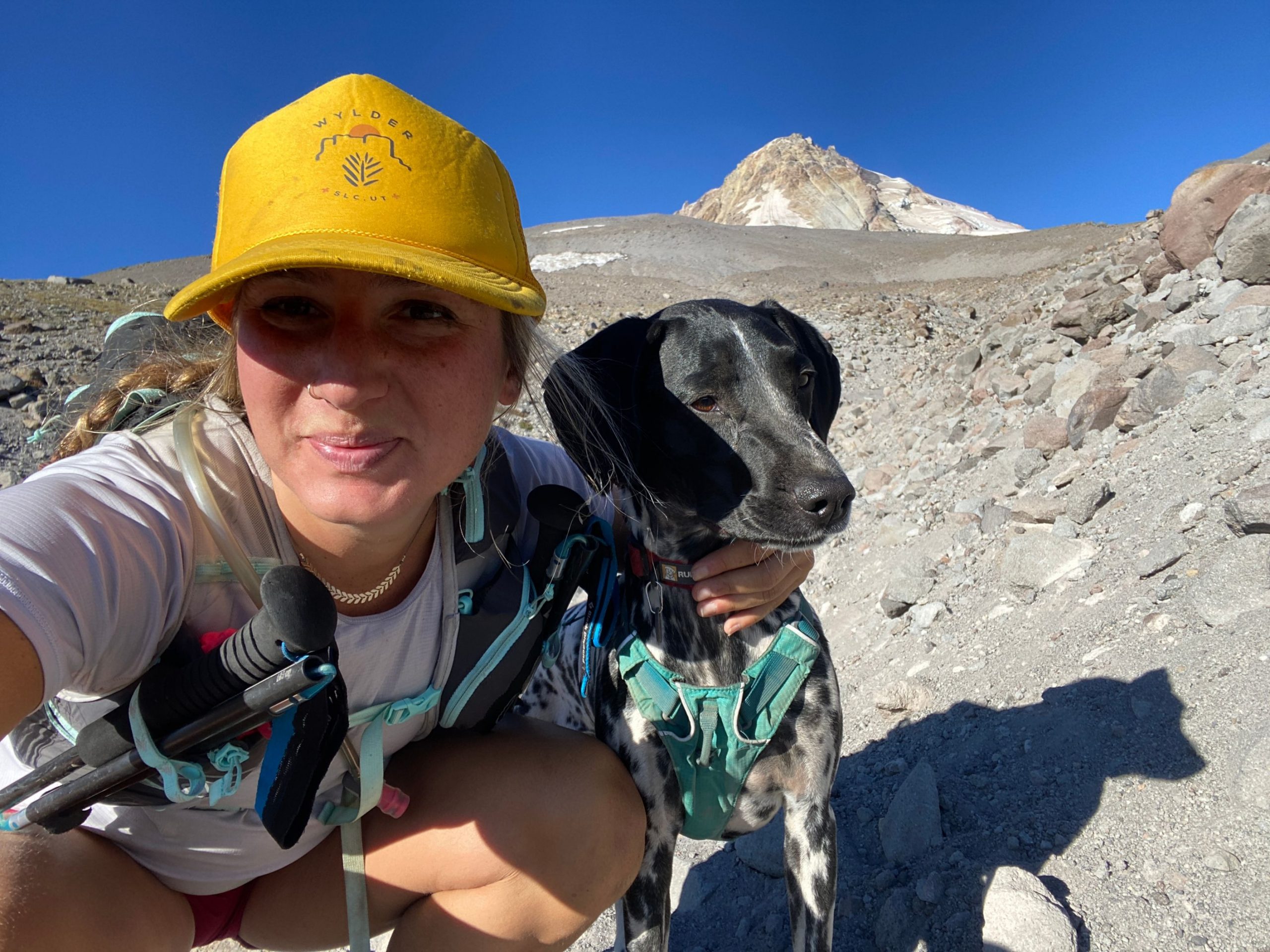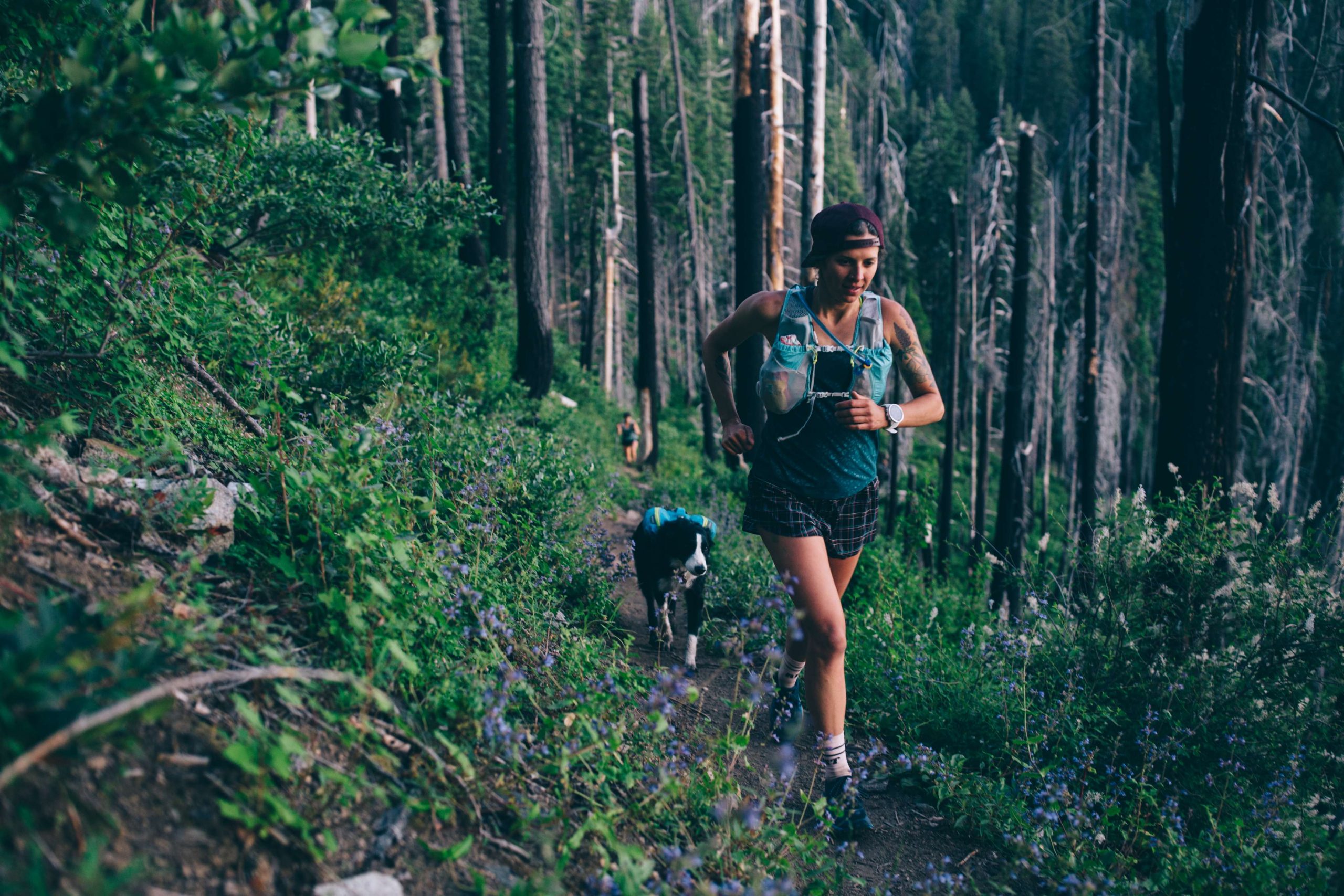T&T? “How do you train your dog to stay with you on the trail?”
Dani: “I started working on recall with my dog, Vilas as soon as we adopted her. We used the command “come” and then rewarded her with a treat each time she returned to our side. I now start most runs by giving Vilas a command and treat at the beginning to remind her that if she listens to me she will be rewarded.”
Alli: “When it comes to other people (and their dogs) on the trail, my preference is that my dogs will completely ignore them. To achieve this, I’d have them step completely off the trail, sit, and focus on me (using treats) while allowing other people to pass. As a puppy, my dog Riggins would bark at other trail users and chase mountain bikers – not ideal for anyone. Practicing getting off the trail (as well as recall) helped us develop better trail behavior. “

Dani and Vilas
T&T: “How do you know how long your dogs can and should run for?”
Alli: “Part of it depends on the dog’s breed, as well as their physical build. I also consult with my vet, and I recommend that other dog owners do so as well. Riggins is a Border collie, which is a breed that was developed to run long distances while herding livestock. Firnspiegel is a 100% mutt, but she has a lot of cattle dog in her, as well as terrier and husky. I think cattle dogs and mutts in general make great long distance trail dogs. Pointers, vizslas, and similar uber high-energy dogs do as well.
Riggins has run 40+ miles with me. I built up his mileage gradually. First, he only joined me on my midweek runs, working up to 8-12 miles. Then, in the teens and low twenties. After a while, he began joining me on almost all of my runs. As his mileage increased, I monitored him for signs of muscle soreness, unusual fatigue, or slow recovery.
A note on longer mileage: Our 25+ or ultra-distance runs are typically quite slow (11-12 minute miles or slower), and Riggins tends to run right behind me or in front of me, so he’s not doing more miles than me. Some dogs run back and forth a lot on the trail, so if their human runs 10 miles, they might be running 15-18.”

Alli and Riggins
Photo Credit Andy Cochrane
T&T: “Do you need to bring fuel for your dog on longer runs?”
Dani: “This is different for all dogs but for my dog the answer is yes. If we are running for more than 3 hours then I fuel for Vilas. I noticed that on longer runs when I would take a snack break, Vilas would be sniffing around my pack looking for food which was a sign to me that she was hungry. So now I carry separate nutrition bags for myself and Vilas. I tend to use a combination of gels, gummies and “real food” like dried mango, peanut butter pretzels and Rice Crispy Treats for myself. For Vilas I pack high protein dog specific treats like chicken jerky, dried duck, cricket balls and peanut butter puffs. I also carry a few dog and human friendly treats like Epic Bars and certain kinds of peanut butter crackers that we share. I try to feed both of us every hour with extended snack breaks built in on longer adventures.”
T&T: “What do you do with your dogs poop on a trail run?”
Dani: “It depends on the regulations where I’m running but I will either dig a hole (6-8″ deep and at least 200 feet away from any water sources) and bury it or I bag it and carry it in my running pack or have Vilas carry it in her running pack. As dog owners we have the responsibility to keep our trails and waterways clean of dog poop and dog poop bags. Both of these can be harmful to our wildlife and ecosystems so it’s important to either pack it out or properly bury your dog’s poop. Here is a great article on impact of dog poop and proper Leave No Trace actions”
T&T: “What is your favorite thing about being able to run with your dog on trails and in the mountains?”
Dani: “My favorite part about being able to run on the trails and in the mountains with my dog is making memories with my best friend. My dog brings so much joy and energy to every single run we go on. She reminds me to slow down and take in the view instead of hurrying along the trail to get to the next mile marker. “
Alli: “It’s incredible to be able to develop a bond with a dog through something that we both love, like trail running or skiing. I think personally, I have tackled some big solo adventure runs with Riggins that I might have hesitated to do totally alone (like running from my house in Bend to the top of South Sister). Having him there takes me out of my own head and puts my focus on him and the experience we’re having together. And some days, it’s 100% the dogs that get me out the door for a run.”
T&T: “Our takeaways from all we got to learn from Alli and Dani are that every dog is different. You have to be patient, learn how your dog operates, take the time to train them so that they will stay right by your side, plan ahead for poop, and definitely bring your dog plenty of good snacks on long runs. All the work you put in building your skills and your dogs will be well worth it from all the incredible experiences you will have on the trail with your best friend!


